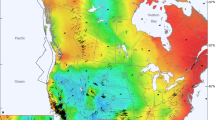Abstract
A simple analogy is made between the tectonics of Asia and deformation in a rigidly indented rigid–plastic solid. India is analogous to the indenter and the great strike-slip faults correspond to slip lines. For various indentation geometries, the sense and linearity (or curvature) of strike-slip faults, convergence at the Burma arc and the existence of the Himalayan Burman Syntax, the conjugate strike-slip faults in Mongolia and the extension at the Baikal and Shansi graben can be predicted. Given the horizontal force necessary to support Tibet, an average shear stress of a few to several hundred bars along faults in Asia is predicted, corresponding to the yield stress of rigid–plastic material.
Similar content being viewed by others
References
Hill, R. The Mathematical Theory of Plasticity (Oxford University Press, 1950).
Backofen, W. A., Deformation Processing (Addison-Wesley, Reading, Massa-chusetts, 1972).
Johnson, W., Sowerby, R., and Haddow, J. B. Plane Strain Slip-line Fields: Theory and Bibliography (American Elsevier Publishing Co., Inc., New York, 1970).
McKenzie, D. P. Geophys. J. R. astr. Soc., 30, 109 (1972).
Molnar, P., and Tapponnier, P. Science, 189, 419 (1975).
Tapponnier, P., and Molnar, P., J. geophys. Res. (in the press).
Mattauer, M., Earth planet. Sci. Lett., 28, 144 (1975).
Mattauer, M., Les Deformations des Materiaux de l'Encore Terrestre (Hermann,Paris, 1973).
Tapponnier, P., and Francheteau, J., J. geophys. Res. (in the press).
Mohajer-Ashjai, A., Behzadi, H., and Berberian, M., Tectonophysics, 25, 281 (1975).
Tchalenko, J. S., Braud, J., and Berberian, M., Nature, 248, 661 (1974).
Peire, A. V., Burtman, V. S., Ruzhentser, S. V., and Suvorov, A. I. Int. Geol. Cong. 22nd Session, Delhi, Part XI, 441 (1964).
Fitch, T. J., J. geophys. Res., 75, 2699 (1970).
Frank, F. C., in Flow and Fracture of Rocks (Geophysical monograph 16, American Geophysical Union, Washington, DC, 1972).
McKenzie, D. P., in The Nature of the Solid Earth, 323 (McGraw-Hill, New York, 1972).
Chen, W.-P., and Molnar, P., J. geophys Res. (in the press).
Author information
Authors and Affiliations
Rights and permissions
About this article
Cite this article
Tapponnier, P., Molnar, P. Slip-line field theory and large-scale continental tectonics. Nature 264, 319–324 (1976). https://doi.org/10.1038/264319a0
Received:
Accepted:
Issue Date:
DOI: https://doi.org/10.1038/264319a0
- Springer Nature Limited
This article is cited by
-
New advances in the study of Tethyan Geodynamic System
Science China Earth Sciences (2024)
-
Probing the interseismic locking state of the Xianshuihe fault based on a viscoelastic deformation model
Science China Earth Sciences (2024)
-
Analyzing the horizontal orientation of the crustal stress adjacent to plate boundaries
Scientific Reports (2023)
-
Three-dimensional kinematics of the India–Eurasia collision
Communications Earth & Environment (2023)
-
Morphometric study of selected river basins from the Meghalaya Plateau — implications for the hydrodynamics of the eastern part of Indian subcontinent
Arabian Journal of Geosciences (2023)





